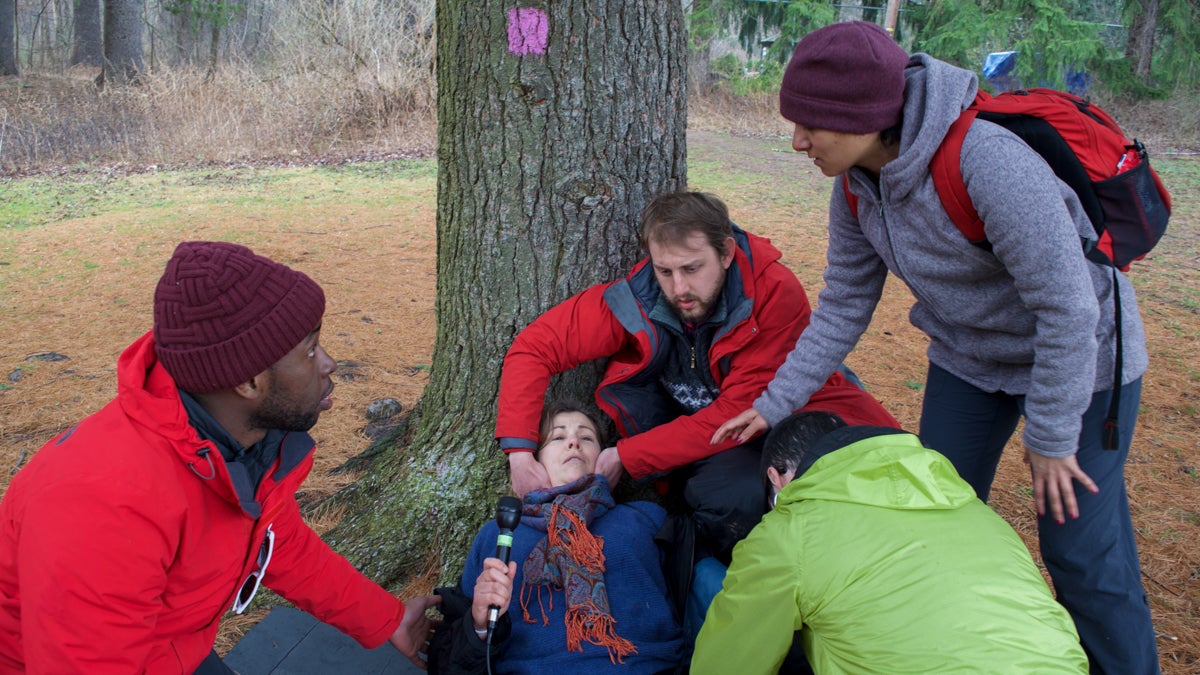From snakebites to leadership, students learn medicine in the wild
Listen
Maiken Scott pretends to be a birder who fell from a tree, while students from the School of Medicine at the University of Pennsylvania examine her. (Paige Pfleger/WHYY)
When you’re trading your medical school classroom for a soggy, chilly nature reserve — you better be prepared.
During a wilderness medicine course, I got to play ‘fake patient’ for a group future doctors from the School of Medicine at the University of Pennsylvania.
“Last night, we had them create shelters that they would sleep in, no tent, no sleeping bag, no matches, no nothing,” says Pete Sananman with a grin. “And it was 38 degrees and raining all night.”
Sananman is an emergency room doctor but looks like a broad-shouldered park ranger in his outdoor gear. He leads the med school wilderness medicine program. He brought his students outdoors for a week to test the skills they learned during the first part of the course.
“Teaching them to be fascicle with providing care in any austere situation. It could be on a roadside with an accident, on an airplane, in the backcountry, it could be in a disaster scenario,” Sananman says.

Pete Sananman on the nature reserve. (Paige Pfleger/WHYY)
The course begins with a week of lectures, where students learn some of the basics of wilderness medicine. They study anything related to over-heating, hypothermia, or altitude sickness. They do deep dives on topics like snake bites, or poisonous mushrooms, working in a disaster zone, what to do after an biological weapons attack, or dealing with limited resources.
“How do you make a splint or stretcher out sticks and whatever gear you have on you,” Sananman says.
All of those skills are put to the test when the students head into the wilderness to camp in week two of the course.
On the day I meet up with them at the nature reserve, the students have taken over a wide meadow near the woods. A steady rain is coming down. It is really cold.
My acting challenge is to be a birder who has fallen from a tree. Sananman has even concocted a backstory for me: I’m a foolhardy hobbyist who climbed a tree to put a baby bird back in its nest.
Before that, I meet Marco Yurachek, a wilderness EMT/makeup artist with bags and boxes of fake blood, purple makeup for bruises and piece of deer leg bone — which he expertly attaches to my leg with flesh-colored wax.

Left, Marco Yurachek, a wilderness EMT/makeup artist. Top right, Yurachek holds fake bones used to simulate injuries. Bottom right, Maiken Scott’s fake bone break. (Paige Pfleger/WHYY)
When he’s done, my leg looks like it’s broken and the bone is sticking out of my flesh. It’s gross. After that I sit under a tree with my back against the trunk with my bloody, mangled-looking leg stretched out. I’m shivering, and I wait for my rescuers.
Finally, they come. A med student named Brian introduces the team. He asks me what happened, and I do my best to be convincing. I whine a little. They evaluate my leg, get it stabilized, and check me head to toe for other injuries. They decide that the best thing to do is to call an ambulance, and to get me to the hospital.
After the team is done taking care of me, the entire group offers feedback — discussing what went well, what they missed.
Sananman says that’s the real value of this extreme training: to learn how to be a leader — or a follower — in tough situations to give the students confidence and boosting their ability to take charge.
For physician and outdoor enthusiast Kevin Gardner, those skill were put to a real test. He’s done with med school and is doing his residency in Oakland, California. A few months after taking the wilderness medicine course in 2015, he was doing an icy, snowy climb of Mount Whitney.
Conditions were tough. He made it to the 14-thousand-foot summit, and then began his journey down, when something caught his eye.
“About 300 feet below me, there appeared to be an animal stumbling around, and then I took a closer look, and I realized it’s a person,” Gardner says.
Gardner saw imprints in the snow that suggested the person had fallen off a cliff, and tumbled down further. He got to the other hiker as quickly as possible, a guy in his 20s, who was in shock and a bit out of it.
“He kept yelling ‘Oh my god, oh my god, I fell, I fell,'” Gardner says.
Gardener says his wilderness training kicked in. He made a heat tent using a garbage bag and put dry clothes on the other hiker. He found no major injuries — and so he guided the other hiker off the mountain. The sun was coming down and temperatures were dropping. They finally made it to base camp after an arduous 10-hour hike.
“I wouldn’t have been as confident and prepared just to deal with the difficult situation. I think what the course does best is to teach you how to think critically,” Gardner says.
Pete Sananman beams with pride when I mention Gardner’s story. Not every student gets to test their skills in such an extreme situation, but Sananman says as long as they feel confident in their ability to lead and follow in situations where it matters, he’s done his job.
WHYY is your source for fact-based, in-depth journalism and information. As a nonprofit organization, we rely on financial support from readers like you. Please give today.







